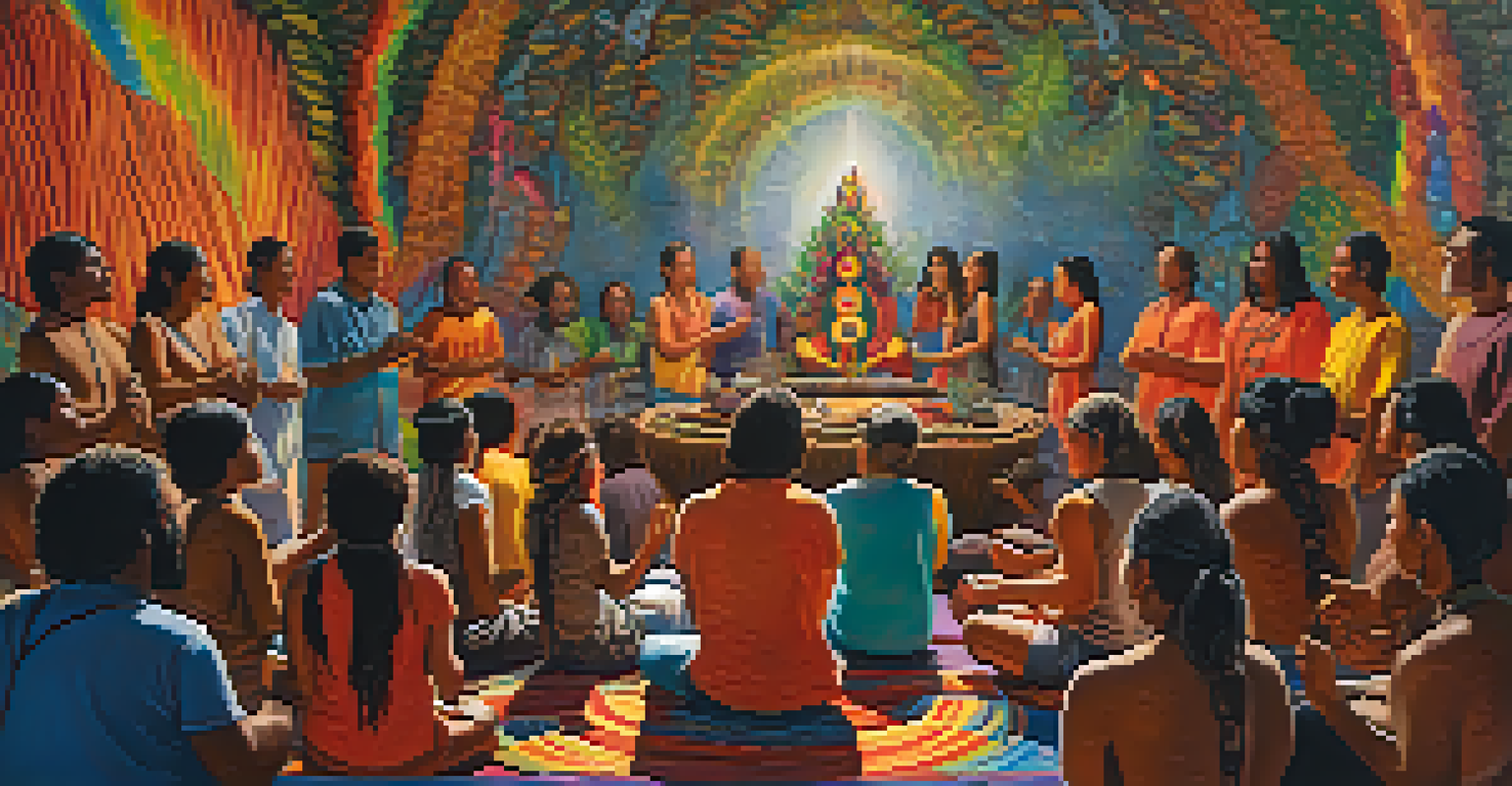Rituals of Ayahuasca: Preparation and Ceremony Insights

Understanding Ayahuasca: A Brief Overview
Ayahuasca is a traditional Amazonian brew made from the Banisteriopsis caapi vine and other plants. It's known for its psychoactive properties and has been used for centuries by indigenous cultures for healing and spiritual growth. By inducing altered states of consciousness, Ayahuasca facilitates profound introspection and insight.
The experience of Ayahuasca is not just about the journey itself but the integration of insights that follow.
The journey with Ayahuasca is often described as a rite of passage, offering participants a chance to confront their fears and traumas. This experience can lead to significant personal transformation, making it a popular choice for those seeking deeper understandings of themselves and their place in the world. Many report feelings of connection to nature and the universe.
Despite its many benefits, Ayahuasca is not a recreational drug; it's a sacred medicine that requires respect and understanding. Participants should approach it with an open mind and a willingness to engage with the process fully.
Preparing for an Ayahuasca Ceremony: Mind and Body
Preparation for an Ayahuasca ceremony is crucial for maximizing the experience. It typically involves a physical and mental cleanse, which may include dietary restrictions such as avoiding alcohol, caffeine, and heavy foods for several days prior. This diet helps make the body more receptive to the medicine.

In addition to dietary changes, participants are encouraged to engage in mental preparation. This can include meditation, journaling, or simply reflecting on personal intentions and what they hope to achieve from the experience. Setting clear intentions helps guide the journey and can enhance the overall effectiveness of the ceremony.
Ayahuasca: A Path to Self-Discovery
Ayahuasca serves as a powerful tool for personal transformation, helping individuals confront their fears and gain deep insights.
Emotional readiness is equally important. Participants should approach the ceremony with a sense of surrender and openness, ready to face whatever insights may arise. This mindset fosters a more profound experience and allows individuals to embrace the journey fully.
Finding the Right Facilitator for the Ceremony
Choosing the right facilitator is a critical step in the Ayahuasca journey. A skilled facilitator ensures a safe environment and can provide guidance throughout the experience. Look for someone with extensive knowledge of the plants, traditions, and the psychological aspects of the journey.
In the depths of our struggles, we often find the light of understanding and healing.
Many facilitators come from indigenous backgrounds and possess a deep understanding of the cultural significance of Ayahuasca. It’s essential to research potential facilitators, read testimonials, and ask questions to ensure they align with your values and comfort level.
Trusting your facilitator is key to having a positive experience. A good facilitator will create a supportive environment that encourages participants to share their experiences and feelings, fostering community and connection during the ceremony.
The Ceremony Setting: What to Expect
The setting of an Ayahuasca ceremony can greatly influence the experience. Typically held in a serene, natural environment, these ceremonies aim to promote a sense of peace and connection with the earth. Many participants find that being surrounded by nature enhances their journey.
Inside the ceremonial space, participants often sit on mats or in circles, creating a communal atmosphere. The use of traditional instruments, such as drums and songs, played by the facilitator, helps guide the experience and deepen the connection with the medicine.
Preparation Enhances the Experience
Proper mental and physical preparation, including setting intentions and dietary restrictions, is essential for maximizing the Ayahuasca journey.
Ceremonies usually start at night and can last several hours, during which participants may experience various emotions, visions, and insights. It's important to remember that each person's journey is unique, and what unfolds during the ceremony can be both unpredictable and transformative.
The Role of Music and Icaros in the Ceremony
Music plays a vital role in Ayahuasca ceremonies. The facilitator often sings traditional songs, known as icaros, which are believed to carry healing vibrations. These melodies help create an emotional landscape, guiding participants through their experiences and facilitating deeper connections with the medicine.
Icaros can evoke a range of emotions, from joy to sadness, and often serve to bring participants back to their center during challenging moments. The power of these songs lies in their ability to resonate with the spirit of the medicine, enhancing the overall journey.
Understanding the significance of music in the ceremony can enrich your experience. Participants may find that connecting with the rhythm and flow of the icaros allows them to surrender to the process more fully, making the experience more profound.
Navigating Challenges During the Ayahuasca Journey
While many participants report positive experiences with Ayahuasca, it's not uncommon to face challenges during the journey. Feelings of fear, anxiety, or discomfort can arise, often as participants confront unresolved issues or traumas. Acknowledging these emotions is a vital part of the healing process.
Facilitators are trained to help participants navigate these challenges, providing support and reassurance as needed. It's important to remember that discomfort can lead to growth and insight, allowing individuals to emerge from the experience with a deeper understanding of themselves.
Integration is Key After Ceremony
Taking time to process and integrate insights gained from the Ayahuasca experience is crucial for long-term personal growth.
Having a trusted support system, including your facilitator and fellow participants, can make a significant difference during difficult moments. Sharing experiences and feelings can foster a sense of community, making the journey feel less isolating.
Integrating Insights After the Ceremony
The period following an Ayahuasca ceremony is crucial for integration. Participants often return to their everyday lives with new insights and perspectives, and taking the time to process these experiences can enhance their long-term benefits. Journaling or discussing the journey with others can provide clarity and help solidify the lessons learned.
Integration also involves making changes in daily life based on the insights gained during the ceremony. This might include adopting healthier habits, shifting perspectives on relationships, or prioritizing personal growth. Taking actionable steps can help maintain the momentum gained from the experience.

Many find it beneficial to engage with communities or support groups focused on Ayahuasca integration. Sharing experiences with others who have undergone similar journeys can foster a sense of belonging and provide ongoing encouragement as you navigate the changes in your life.